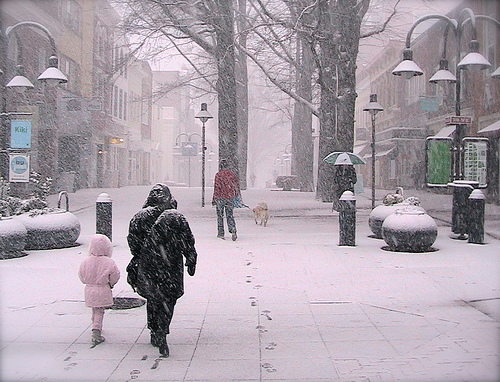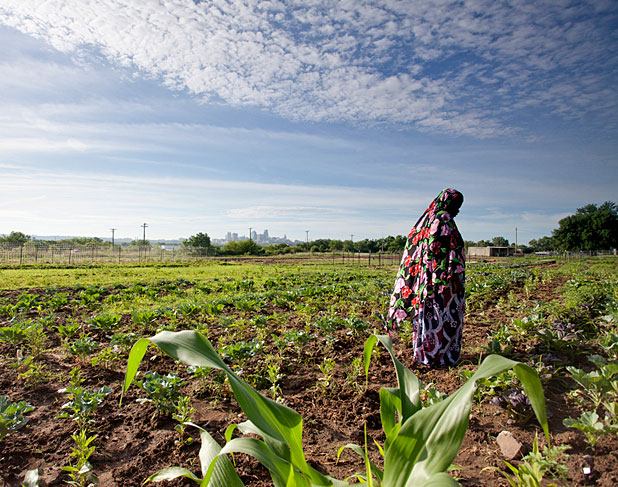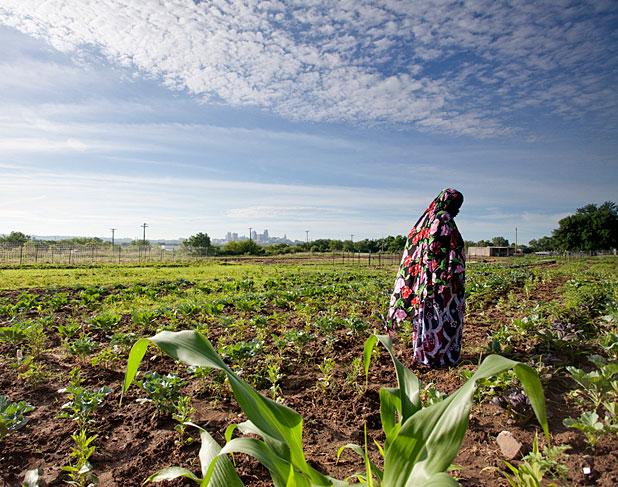
(Michael Hanson photos)
Seven women in ankle-length floral dresses bend at the waist in rows of kale, arugula, and kohlrabi. Their hands effortlessly scoop and pick and cut the stems and pull the weeds. The low sun is already hot coming through the hazy white sky that makes the Kansas City downtown in the distance look like a mirage. Low-slung brick buildings of the Juniper Gardens public housing project line one side of this seven-acre farm. It’s hard to know which is more out of place, more of a mirage: the city, the farm, the dried-out yards of the apartments, or the farmer women from Burundi, Somalia, Burma, Bhutan, or Sudan.
The Catholic Charities of Northeast Kansas City started the city’s Farm Business Development Program in 2006. The area sees many refugees from Africa and Asia, and some of the women receive classes and support at the Catholic Charities center.
Rachel Bonar directed the women’s programs there in 2005. She heard the women asking for a garden, since most of them farmed or at least gardened in their native homes. So they started a community garden at the office. “Almost immediately, we realized that these women are really good at growing food,” says Rachel. “So the next year we partnered with Kansas City Center for Urban Agriculture and began this farm.”
The New Roots for Refugees Farm is part community farm and part Farm Business Development Program. The business program acts as an incubator farm for 14 women. Once accepted into the program — and after at least one year with a community garden plot — the farmers receive a quarter-acre plot. For the first year, everything is paid for, including seeds, tools, water, and marketing. Rachel even sets up two CSA members who pay to support the plot’s crop. Gradually, the farmers take on more responsibility.
In the winter, the farmers take courses in planning, production, marketing, and farming/market-oriented English instruction. In their second and third years, they begin paying for things like seeds (purchased on site from the seed store), marketing, and tools. They organize their own CSA member shares (between three and seven, normally). Rachel and the organization still shuttle them to and from the farmers markets on the weekend, but the women are on their own selling the produce.
On Saturday morning, we followed them from the farm to a market in Brookside, an upper-middle-class neighborhood south of downtown. Six New Roots farmers sell here, mixed in with the grass-fed beef booth, the artisanal bread-and-cheese gang, and other organic produce vendors. The women looked elegant and proud in vibrant dresses and evening shoes. Their produce was immaculate and some exotic, native to their homelands but able to be cultivated here.
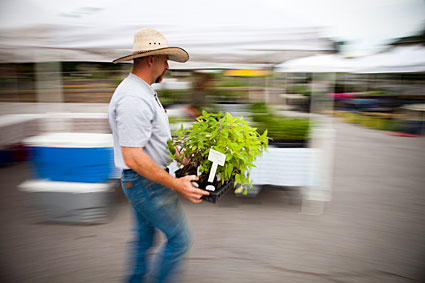
A farmer bringing produce to his stand at the Brookside Farmers Market
“I really have seen these women’s disposition change,” Rachel says. “They move here and don’t find anything they’re good at. The language, the systems, etc. are all challenges. They aren’t really eligible for other employment. Some go to the meat processing plant to work, but it’s so difficult there and restricted. Here they have ownership. It’s self-determination. Everyone needs something they’re good at, and these women are proud to provide ethnic food to their community. Some weekends Dena Tu [a Karen from Burma] drives hours to Omaha to bring ethnic veggies to the Karen population up there.”
The hope is that after three years, the farmers can take the annual $200 of their sales they’ve been saving and start their own independent farm on a vacant lot within the neighborhood. Though it’s a long shot that they’ll be able to single-handedly support their families — most have husbands working full-time — the farms offer an invaluable monetary supplement, as well as filling the fridge and satisfying that essential human hunger for productivity and worthiness.
At this same Brookside Farmers Market, I meet Katherine Kelly. She’s the executive director and cofounder (with Dan Dermitzel) of the Kansas City Center for Urban Agriculture (KCCUA), the other half of the New Roots for Refugees Farm project and a supporter of dozens of other farms and gardens in the city.
The KCCUA farm stand has the first tomatoes of the season. While KCCUA itself is a nonprofit organization, it farms a prolific two acres in the city for a profit. Farm sales have contributed more than $22,000 into the organization over the last three years.
Katherine grew up working on neighbors’ farms in Kansas, the for-profit kind. While working in Boston, she noticed a few nonprofit gardens in and around town.
“Part of me felt that making the farm a nonprofit says that it isn’t viable,” she explains. “It acts like a museum, and it’s run like a museum sometimes. Farming shouldn’t be like that.” She isn’t black and white on the issue, however: “I have to say there is a particularly Midwestern emphasis on the free market as the solution. I don’t like a lot of that — the idea that capitalism is the solution to everything. But I believe in small businesses, and I know and see how proud the owners are of their businesses.”
KCCUA as an umbrella organization is a nonprofit. It supports small projects in the city, farmers like Lew Edminster and Sherri Harvel who farm vacant lots and sell their produce at small weekly markets for a profit and an income supplement.
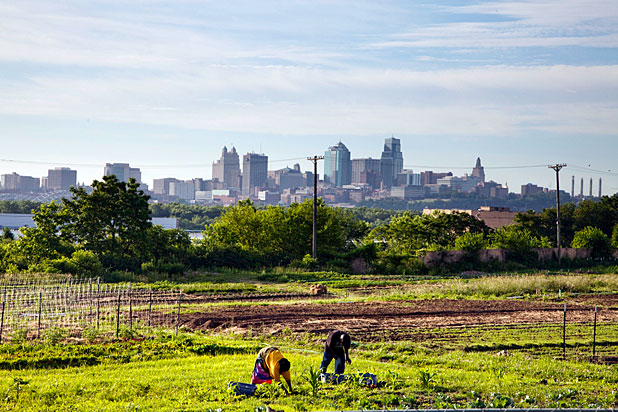
The Kansas City skyline is an incongruous backdrop to New Roots farm.
Speaking with Katherine feels like taking a giant evolutionary step. Like she and KCCUA are operating years ahead of the current situation. And yet it’s not idealism that sits around the corner in this movement’s progression forward — it’s stone-cold practicality, the American Way of supplying a demand by selling valuable goods to consumers, and making a profit from it. On the whole, Katherine believes that a new food industry must be created: “Home gardeners, community gardeners, commercial gardeners. Small farms, medium farms, large farms. When you’ve got that mix, you’ve got resilience and sustainability. You’ve got knowledge that passes along and a support infrastructure with the tools, supplies, services being a part of that. Then you’ve got an industry, a really healthy community of industry.”
I ask her if this industry will grow out of the city and the visionaries like herself. Must it start here and then move into the surrounding “farmland”?
“We’re land-abundant and farmer-poor,” she says. “I’ve had so many people call me with 100 acres and no one to farm it. People live in cities, so at some level we have to deal with that.”
